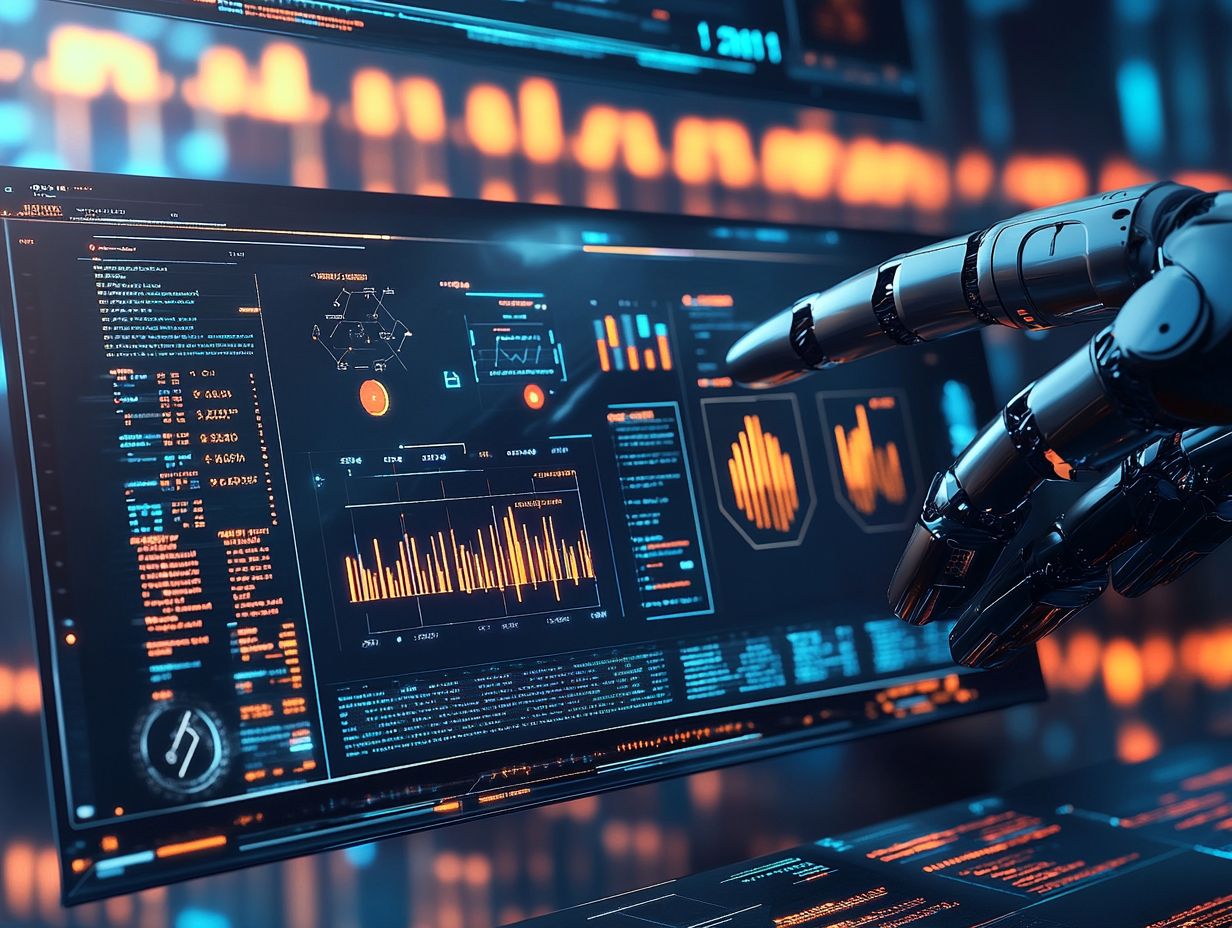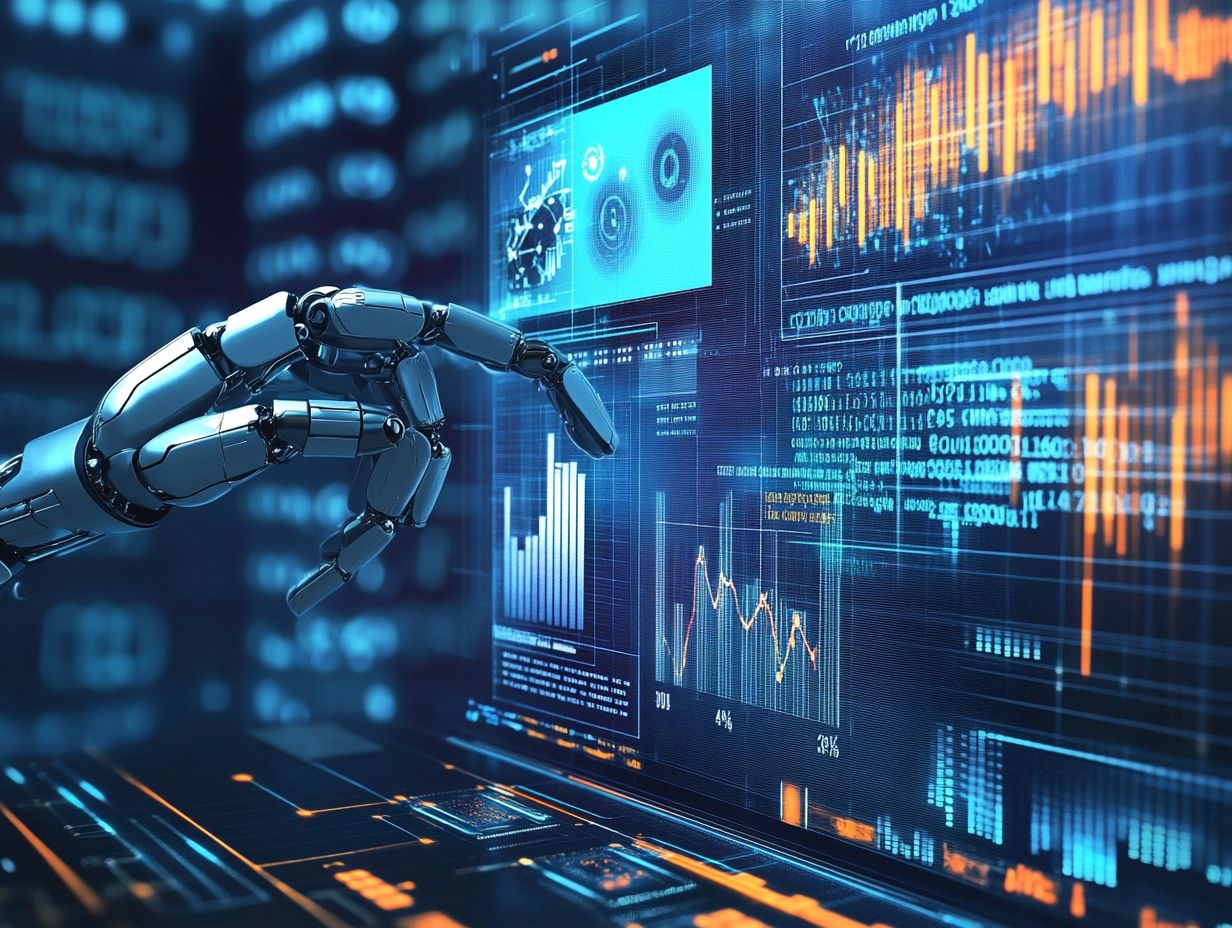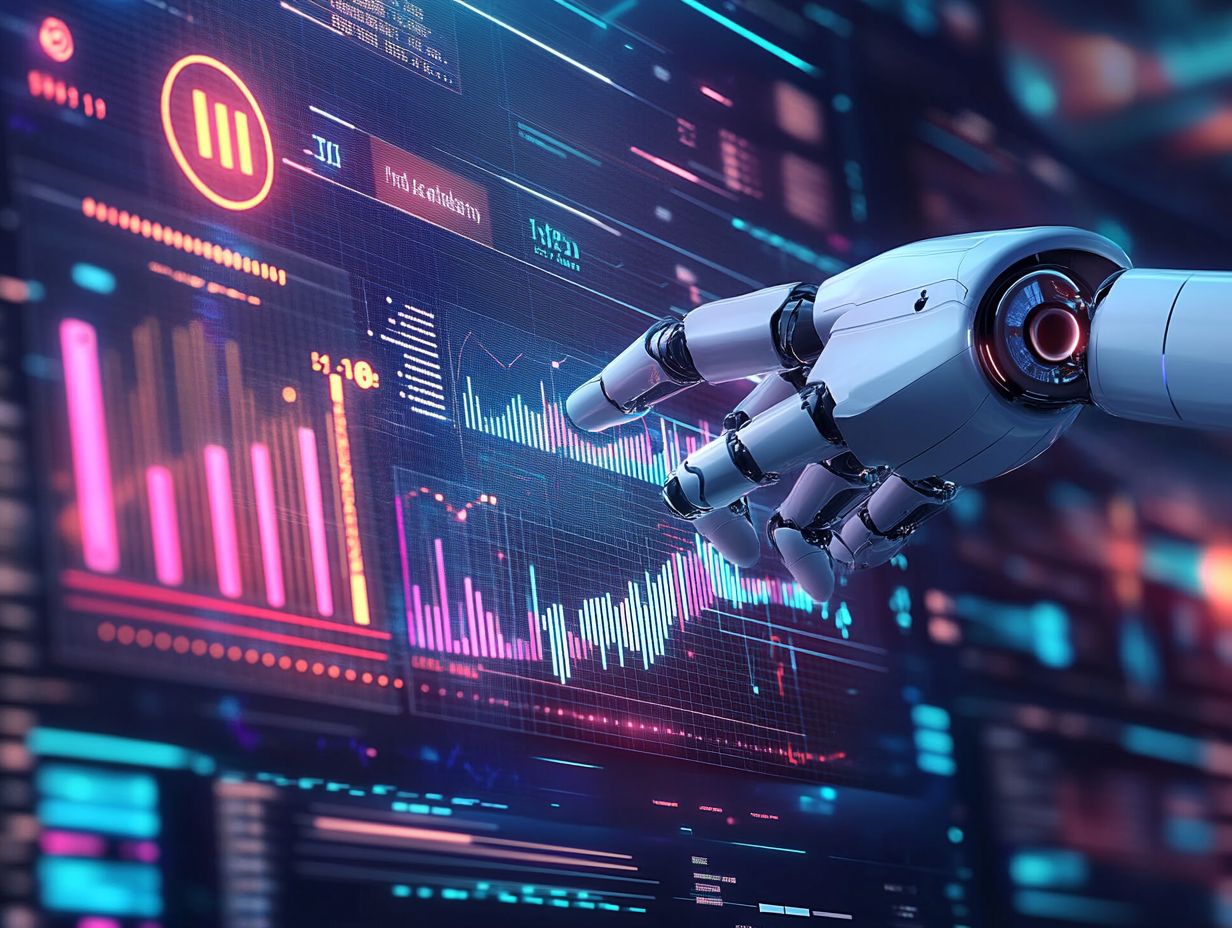The Role of AI in Analyzing and Optimizing Click-Through Rates (CTR)
In the fast-paced realm of digital marketing, grasping the intricacies of Click-Through Rate (CTR) is essential for evaluating the success of your campaigns. This article delves into the fundamentals of CTR, covering everything from its calculation to its importance in your digital strategies.
You’ll also discover how technological advancements are transforming CTR analysis and optimization, equipping you with tools and techniques that enhance targeting and efficiency.
Furthermore, we will tackle the challenges and future prospects in this field, offering a thorough overview that will elevate your marketing efforts to new heights.
Contents
- What is Click-Through Rate (CTR)?
- Why is CTR Important for Digital Marketing?
- How Has AI Impacted CTR Analysis and Optimization?
- What Are the Benefits of Using AI for CTR Analysis and Optimization?
- What Are the Challenges of Using AI for CTR Analysis and Optimization?
- What is the Future of AI in CTR Analysis and Optimization?
- Frequently Asked Questions
- What is the role of AI in analyzing and optimizing click-through rates (CTR)?
- How does AI analyze click-through rates?
- What are some benefits of using AI to optimize click-through rates?
- Can AI help businesses of all sizes with CTR optimization?
- How can AI be used to continuously optimize click-through rates?
- Is AI the future of click-through rate optimization?
What is Click-Through Rate (CTR)?

Click-Through Rate (CTR) is a vital metric in the realm of digital marketing, representing the percentage of users who engage with a specific link, ad, or call-to-action relative to the total number of users who encounter that content.
Grasping the nuances of CTR is essential for you as a marketer, as it directly influences user engagement and the effectiveness of your advertising efforts. A higher CTR typically signifies that your marketing strategies are resonating well with your target audience, funneling more traffic to your website and ultimately enhancing your conversion rates.
In the world of digital marketing, optimizing CTR is crucial for achieving the ROI you desire and elevating your overall campaign performance.
How is CTR Calculated?
Calculating your Click-Through Rate (CTR) is a simple yet powerful process. You just divide the number of clicks on a specific link or ad by the total number of impressions, then multiply the result by 100 to express it as a percentage.
For instance, if your ad attracted 100 clicks from 1,000 impressions, your CTR would stand at a solid 10%. This straightforward data analysis technique enables you to evaluate your advertising campaigns’ performance and make informed decisions based on the results.
Grasping how to calculate CTR is essential for any business looking to elevate its online presence. It serves as a vital metric for measuring engagement and the effectiveness of diverse marketing strategies.
By keeping a close eye on this metric, you can fine-tune your campaigns, sharpening your focus on high-performing advertisements while also pinpointing underperforming elements that might need some adjustments.
CTR is intricately connected to the algorithms employed by various digital marketing platforms, which assess ad relevance and quality, significantly influencing your overall visibility and reach. By leveraging CTR in your metrics analysis, you can enhance ad performance and substantially boost your conversion rates.
Why is CTR Important for Digital Marketing?
The significance of Click-Through Rate (CTR) in digital marketing truly cannot be overstated. It serves as a crucial indicator of how well your content connects with your audience and stimulates engagement.
When you achieve a higher CTR, it usually means your audience targeting is spot on, compelling users to take action be it clicking a link, signing up for a newsletter, or making a purchase.
By diligently monitoring and optimizing your CTR, you can elevate conversion rates, enhance the user experience, and ultimately amplify your marketing analytics efforts to achieve superior results across your ad campaigns.
How Has AI Impacted CTR Analysis and Optimization?
Artificial Intelligence (AI) has transformed the landscape of Click-Through Rate (CTR) analysis and optimization, offering sophisticated tools and methodologies that refine your data-driven decision-making processes.
By leveraging the capabilities of machine learning algorithms, you can sift through extensive datasets to uncover trends, user behaviors, and preferences, leading to enhanced predictive analytics.
This evolution enables you to craft more targeted campaigns and optimize your strategies, ultimately boosting CTR while enriching your overall marketing performance.
By tailoring content to align with user intent and engagement patterns, you position yourself at the forefront of marketing excellence.
What AI Tools are Used for CTR Analysis?
Several AI tools have become critical assets for you as a marketer looking to enhance your Click-Through Rate (CTR) analysis. These platforms, such as Google Analytics, HubSpot, and Adobe Analytics, leverage sophisticated algorithms to dissect user behavior, offering you actionable insights that can shape your marketing strategies. By incorporating these marketing technologies, you can effectively track and optimize your campaigns, leading to higher engagement and improved results.
Not only do these tools help you monitor CTR, but they also allow for in-depth exploration of audience segmentation, ad performance, and conversion funnels, giving you the ability to visualize your data in real-time. For example, platforms like Tableau and Microsoft Power BI elevate your data storytelling, transforming complex datasets into intuitive dashboards. This clarity enables you to quickly spot trends and make confident, data-driven decisions.
Moreover, AI-driven predictive analytics can give you a glimpse into future performance metrics, allowing you to tailor your marketing initiatives with more precision and ultimately drive greater ROI. The integration of these advanced tools into your marketing practices is proving to be nothing short of transformative.
How Does AI Improve CTR Optimization?
AI significantly amplifies your Click-Through Rate (CTR) optimization by automating various processes and offering deeper insights into engagement metrics and user behavior.
This cutting-edge technology enables you to efficiently analyze vast amounts of data, revealing patterns and trends that might slip through the cracks with manual efforts. By harnessing behavioral analytics, AI systems can uncover valuable insights into user preferences and histories, allowing you to deliver tailored content that resonates profoundly with your specific target audiences.
The ability to segment audiences based on these insights ensures that your marketing messages are not only relevant but also timely. Such personalization captures user attention and fosters sustained engagement, ultimately leading to higher CTR and more successful marketing outcomes.
What Are the Benefits of Using AI for CTR Analysis and Optimization?

Leveraging AI for Click-Through Rate (CTR) analysis and optimization offers a wealth of advantages that can elevate your marketing endeavors and strengthen your overall performance metrics.
By tapping into the capabilities of machine learning and data analysis, you gain profound insights into customer behavior, enableing you to design targeted campaigns that truly resonate with your audience.
This technology not only simplifies the optimization process but also enhances the effectiveness of your marketing analytics, leading to increased engagement rates and a significantly improved ROI.
1. Improved Targeting
AI enhances your targeting capabilities by harnessing audience segmentation and behavioral data, allowing you to deliver personalized content that truly resonates with users. With the help of advanced algorithms, you can pinpoint and connect with specific demographics, thereby increasing the relevance of your ad campaigns and driving higher click-through rates.
This level of precision in your targeting strategies ensures that the right messages reach the right individuals at just the right moments, revolutionizing how brands like yours engage with their audiences. By carefully analyzing user interactions and preferences, you can create tailored experiences that not only grab attention but also inspire meaningful interactions.
As a result, your communication strategy becomes more effective, elevating user engagement and fostering brand loyalty. This translates into higher conversion rates and a more significant return on investment, ultimately enhancing your overall marketing effectiveness.
2. Real-time Monitoring and Adjustments
With AI at your disposal, you can enjoy the advantages of real-time monitoring and adjustments, enabling you to track Click-Through Rate (CTR) and optimize your campaigns based on immediate performance metrics. This capability allows you to respond swiftly to shifts in user behavior, making data-driven adjustments that enhance both engagement and effectiveness.
Utilizing advanced algorithms, AI not only sheds light on your current CTR but also identifies patterns that signal when adjustments might be necessary. This immediacy enables you to pivot your strategies, test variations rapidly, and improve ad relevance all while keeping a close watch on how each alteration affects your performance metrics.
By understanding click tracking details, you can adopt a more nuanced approach to your target audiences, ensuring your outreach is both timely and relevant. These real-time capabilities lead to well-considered choices, ultimately driving higher conversion rates and improving ROI for your marketing efforts.
3. Increased Efficiency and Cost Savings
AI enhances the efficiency and cost-effectiveness of CTR analysis and optimization by automating repetitive tasks and streamlining workflows. This means you can reduce the manual effort involved in data analysis and campaign adjustments, allowing you to allocate your resources more effectively and, ultimately, improve your ROI.
This technological advancement doesn t just cut down on human error; it also accelerates your decision-making process, enabling you to pivot strategies in real-time based on actionable insights. With the implementation of automated reporting tools and AI-driven analytics platforms, you can focus on high-impact activities rather than getting bogged down in tedious data crunching.
Moreover, integrating marketing technology allows for personalized customer interactions and targeted campaigns, leading to higher engagement rates. As a result, you can enjoy significant cost reductions while reaping the benefits of enhanced accuracy and scalability in your marketing efforts.
4. Better Understanding of Consumer Behavior
Utilizing AI in CTR analysis offers you a profound understanding of consumer behavior, delivering valuable insights that can effectively shape your campaign strategies. By examining patterns and trends, you can align your content with user intent, resulting in higher engagement rates and an enhanced user experience.
This process involves sifting through substantial volumes of data to pinpoint what truly resonates with your target audience. Through this sophisticated analysis, you can uncover hidden preferences, emotional triggers, and potential barriers that sway purchasing decisions.
Such insights enable you to create tailored messaging that not only grabs attention but also fosters a deeper connection with consumers. With a clearer understanding of user engagement metrics, you can pivot more adeptly in real-time, optimizing your outreach efforts to ensure you stay relevant and impactful in an ever-evolving marketplace.
What Are the Challenges of Using AI for CTR Analysis and Optimization?
While AI presents a wealth of advantages for analyzing and optimizing Click-Through Rates (CTR), you must also navigate several challenges to harness its full potential effectively.
Issues like data privacy concerns and reliance on high-quality data can obstruct the successful integration of AI tools into your marketing strategies. Additionally, algorithmic biases may skew the accuracy of insights and optimizations, which means you ll need to engage in careful monitoring and adjustments to ensure your efforts yield the desired results.
1. Data Privacy Concerns

Data privacy concerns pose a significant challenge for you when implementing AI in Click-Through Rate (CTR) analysis. You must carefully navigate the regulations surrounding user data collection and usage. Striking the right balance between effective targeting and respecting user privacy is essential to maintaining trust and ensuring compliance.
As you increasingly rely on data-driven insights to enhance your marketing strategies, the implications of regulatory frameworks like GDPR and CCPA become even more critical. You must ensure that user consent is obtained before collecting any data, safeguarding sensitive information against misuse. Ethically handling data not only aligns with your legal obligations but also fosters a culture of transparency.
Neglecting these standards could lead to hefty penalties and damage to your reputation, ultimately impacting user engagement. Thus, prioritizing ethical data usage and implementing robust privacy measures will be vital for you as you aim to leverage AI technologies effectively while respecting individual privacy rights.
2. Dependence on Quality Data
The effectiveness of AI in analyzing Click-Through Rates (CTR) hinges on the quality of the data you collect. If the data is inaccurate or incomplete, you risk drawing misguided insights and crafting suboptimal optimization strategies. It s crucial to ensure that your data collection methods are reliable, as this is the foundation for making informed AI-driven marketing decisions.
When you overlook the importance of maintaining high-quality data standards, you expose yourself to the risk of reaching conclusions that fail to accurately represent user behavior or the effectiveness of your campaigns. Such inconsistencies can significantly distort your analytics, leading to flawed decision-making and ultimately squandering your marketing resources.
Accurate and robust data collection enables you to grasp trends, preferences, and insights with greater precision, which is essential for tailoring campaigns that truly resonate with your target audience. Therefore, investing in a reliable data infrastructure is not merely a technical requirement; it is a critical strategic necessity in today s fiercely competitive landscape.
3. Potential for Bias
The potential for bias in AI algorithms presents a significant challenge for your CTR analysis, as biased data can distort results and adversely affect your marketing strategies. It’s vital for you to remain vigilant in monitoring AI systems to mitigate bias and ensure fairness across all your campaigns.
This vigilance is not merely a recommendation; it is essential. Algorithmic bias can erode trust and lead to misleading performance metrics, which may result in ineffective targeting and lost revenue opportunities. It’s important to acknowledge that such biases often arise from historical data reflecting societal inequalities or flawed assumptions baked into the algorithms themselves.
To combat this issue, you should consider implementing strategies such as:
- Conducting regular audits of your data sets,
- Utilizing diverse data sources,
- Incorporating fairness metrics into your analytical processes.
By proactively identifying and addressing these biases, you can cultivate more equitable marketing practices that resonate effectively with a diverse audience.
What is the Future of AI in CTR Analysis and Optimization?
The future of AI in Click-Through Rate (CTR) analysis and optimization looks incredibly promising for you, as ongoing advancements in AI technology are poised to transform your marketing strategies even further.
With the evolution of machine learning models, you can anticipate the arrival of more sophisticated tools that will refine predictive analytics and user engagement metrics. This progress will seamlessly work together with your other marketing strategies, amplifying your results and elevating your overall performance.
1. Continued Advancements in AI Technology
Continued advancements in AI technology offer you enhanced capabilities for Click-Through Rate (CTR) analysis, allowing for more precise predictive modeling and deeper insights into user behavior. As machine learning continues to evolve, you’ll find that these tools equip you with unparalleled data analysis capabilities, refining your targeting and engagement strategies like never before.
With more sophisticated algorithms at your fingertips, you can expect AI-driven tools to analyze past performance and predict future trends with remarkable accuracy. The integration of deep learning techniques will enable you to uncover subtle patterns in user interactions, which are crucial for crafting effective marketing campaigns.
Furthermore, the implementation of real-time analytics will enable you to adjust your strategies on-the-fly, ensuring that you stay relevant in a rapidly changing digital landscape. Ultimately, these advancements in AI will lead to more personalized user experiences and significantly improved CTR outcomes for your campaigns.
2. Integration with Other Marketing Strategies
The integration of AI with your marketing strategies is poised to elevate Click-Through Rate (CTR) optimization across various channels, cultivating a more cohesive marketing ecosystem. By fusing AI insights with multi-channel marketing approaches, you can craft unified campaigns that truly resonate with diverse audience segments.
This integration enables you with real-time data analysis, allowing you to adapt your strategies swiftly based on performance metrics. Consequently, your audience targeting becomes more precise, significantly enhancing engagement rates.
AI-powered tools can uncover trends and patterns that might otherwise go unnoticed, helping you create tailored content that addresses the unique needs of consumers across different platforms.
The synergy between AI and multi-channel marketing not only streamlines your operations but also strengthens your brand presence, ensuring that your messages are consistently delivered and ultimately driving higher conversion rates.
3. Personalization and Customization

The future of AI in Click-Through Rate (CTR) analysis is making waves with a keen focus on personalization and customization, allowing you to tailor your marketing efforts to suit individual user preferences and behaviors. By leveraging the capabilities of AI, you can create more engaging experiences that resonate with your target audience and significantly enhance your overall CTR.
This transformation is essential in today s digital landscape, where user expectations are constantly shifting. When you implement personalization strategies backed by data-driven insights, you’re able to present content that not only grabs attention but also invites interaction.
AI technologies sift through vast amounts of data to decode user journeys and preferences, enabling you to align your marketing strategies with specific needs. This elevated level of customization directly influences user engagement, paving the way for increased conversion rates.
Ultimately, by providing a seamless user experience through informed AI applications, you cultivate trust and loyalty, positioning your brand favorably in an increasingly competitive market.
4. Ethical Considerations
As you navigate the evolving landscape of Click-Through Rate (CTR) analysis and optimization, it’s essential to prioritize ethical considerations surrounding data usage and user trust. You need to establish transparent practices that respect user privacy while harnessing AI’s capabilities to enhance your marketing outcomes.
This requires you to develop clear communication strategies that inform users about how their data is collected, stored, and utilized. By embracing ethical marketing practices, you can foster an environment of trust an essential component for maintaining customer loyalty in today’s digital world.
Utilizing anonymization techniques and obtaining explicit consent when you tap into user data can significantly boost user confidence. By striking a balance between leveraging AI’s analytical power and upholding data privacy standards, you’ll not only protect consumers but also enhance the effectiveness of your marketing campaigns in a responsible way.
Frequently Asked Questions
What is the role of AI in analyzing and optimizing click-through rates (CTR)?
AI plays a crucial role in analyzing and optimizing click-through rates by using data and algorithms to make data-driven decisions and improve CTR.
How does AI analyze click-through rates?
AI uses machine learning algorithms to analyze click-through rates by examining various factors such as user behavior, audience demographics, and past performance data.
What are some benefits of using AI to optimize click-through rates?
Some benefits of using AI to optimize CTR include improved targeting, increased efficiency, and higher conversion rates due to more targeted and personalized marketing strategies.
Can AI help businesses of all sizes with CTR optimization?
Yes, AI can benefit businesses of all sizes by providing valuable insights and recommendations for improving CTR, regardless of their budget or resources.
How can AI be used to continuously optimize click-through rates?
AI can be used to continuously optimize CTR by constantly analyzing data and making real-time adjustments to marketing strategies, ensuring that the best-performing tactics are always being used.
Is AI the future of click-through rate optimization?
Many experts believe that AI will play an increasingly important role in CTR optimization as technology continues to advance and businesses strive for more targeted and efficient marketing tactics.






